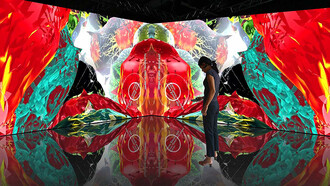I am not normally given over to reviewing selling shows, but this 35th edition of the ‘Small is Beautiful’ at Flowers in London grabbed me rather unexpectedly as something to write home about – not literally of course. I guess ‘Small is Beautiful’ has become something of a tradition for me given that I first saw it only a couple of years after it started in 1976, and throughout this time of course there have been both artistic and curatorial highs and lows.
The current cross-section includes many of Flowers’ more established names, but is none the less interesting for that. Gavin Turk, Nicola Hicks, John Carter, Clyde Hopkins and Maggi Hambling are just few of those who have staked a claim in a very British version of recent art history. I don’t say this as any kind of indictment or accusation, but as I take the slow run-up to my own increasing maturation, played out against the incessant and blurring effects of social media hype promoting ‘new art’, there is an endearing sense of refuge to be found in Flowers’ understated confines.
Particular highlights of the show for me were the dreamy and unattainable silhouettes of Asiatic trees captured in Bomoon’s ‘Untitled (Tiannmenshan, Mt. Gate to Heaven)’ from 2015 and Carol Robertson’s new, meticulous and wondrous ‘Pointstar’ (2017) series. The impossible perfection of these oil paintings and the diverse readings they offer (from the stellar/biblical through to the graphic Rediffusion logo of the 1960’s) offer the viewer an infinite visual invitation to mindfulness.
Nicola Hicks’ accomplishments are known to many, but as a draughtsperson extraordinaire she remains virtually unsurpassed. Not since Henry Moore have I seen such an understanding of and empathy with Animalia in its various forms. Her monochrome etchings, though not all recent, weave and thread captivating intaglio around the forms of Jersey cows, sheep and chickens. At the time of writing, I recognise that I am not advocating from my more accustomed position, any kind of conceptual nouveau avant-garde or the ontologies of arte povera, but a kind of artistic accomplishment borne from practice, material understanding and sensibility. Lest you mistake this narrative for some kind of reactionary advocacy of art-as-craft retreat, I can assure you it is not, but what I would say is that not all art has to be spectacular, museum-sized or comprised of infinite multiples that fill the visual event-horizon.
John Carter presents us with intimately tessellated painted plywood panels in a restrained palette and with a scaled planar presence that are joyful in their contrapposto and mischievous in their evocative provocation of contemporary abstraction. I will save the very best ‘til last though. Natalie Arnoldi’s cinematic and Hopperesque oil renditions offer a monochromatic and atmospheric depiction of ghastly filling stations. The stuff of nightmares straight from a scene in Lynch’s Eraserhead, the relatively small scale paintings impact way beyond their modest 15 x 20cm size.
The works here are small and some perfectly formed, and the show is but short lived like the transient opening of some exotic bloom. Nonetheless if you should happen by, pop-in and you will be enthralled by the modesty and creativity within the unconfined beauty of small-scale.















